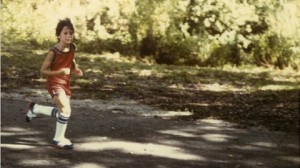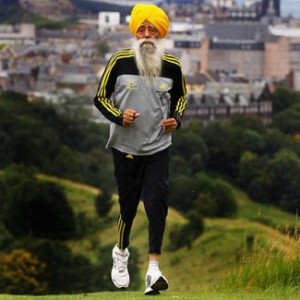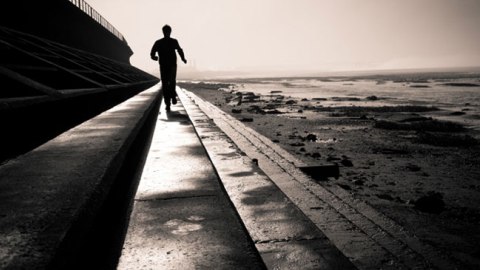I met Lamar shortly after returning to California in the 1980’s. Deciding to get my college degree at 30, I had landed at a small school in the geographical center of the state. The lines on a new, red track had just been painted, and Lamar and I were the first people to run on it. He was 75.
 At the time, I had the usual images of aging—the body as well as the mind inexorably slowed down and wore out. Having been a decent sprinter for a white boy when I was younger, and raised during an era when 25 was old and washed up for a sprinter, I thought men’s legs inevitably tended toward skin and bones by the time they were 70.
At the time, I had the usual images of aging—the body as well as the mind inexorably slowed down and wore out. Having been a decent sprinter for a white boy when I was younger, and raised during an era when 25 was old and washed up for a sprinter, I thought men’s legs inevitably tended toward skin and bones by the time they were 70.
But here was a 75-year-old guy running sprints on that brand new track, with legs that looked like a young man’s. I didn’t know what in the hell to make of it.
Though some people who had lived in Turlock for decades didn’t believe me, on a really clear day you could make out Half Dome in Yosemite Valley with the naked eye. Yosemite was over 100 miles by car from Turkey Tech, as they called Stanislaus State in those days. Half Dome was half that distance as the crow flies, and was an astounding sight once you made it out.
Lamar knew this and many other things. Pointing into the obscurity over the fields from the far end of the track, I glimpsed the characteristic sheer granite wall of Half Dome, and was speechless. That was the beginning of many lessons he taught me.
I confided in him that I’d always wanted to run college track, but that it was too late now. Besides, I had only one term left. You can imagine how he laughed at a 30-year-old saying such a thing.
“You have 98% of whatever speed you had at 18. If you really want to compete, go out for the team.”
So the next day I dug out my old red velcro spikes from high school, which I hadn’t worn in a dozen years, and, after  carefully warming up, ran an easy 100. It felt good, but my legs had begun to shrink on their way to the self-fulfilling prophecy of skin and bones, and they would need a lot of work.
carefully warming up, ran an easy 100. It felt good, but my legs had begun to shrink on their way to the self-fulfilling prophecy of skin and bones, and they would need a lot of work.
It was late fall, and the track team started workouts shortly after returning from winter break in late January. I asked Lamar if he’d help me come back, and he agreed. We met on the track once or twice a week, and he’d give me pointers. We talked about a lot of things besides track however.
Not long before, one of the all-time best track films had come out, “Chariots of Fire,” which won the Oscar in 1981. It’s the story of one British sprinter who runs in the face of anti-Semitism to prove something to the world, and another, a devout Scot, who runs because “God made me fast, and when I run I feel his pleasure.”
The climax of the movie comes at the 1924 Olympics in Paris. The Americans in the film are portrayed a little ludicrously as hyper-kinetic, cocky, and masters of technique without heart. It turned out that Lamar actually knew and competed against one of them in the ‘30’s!
Without a bit of braggadocio, Lamar said he was a national class but not world-class sprinter. “I could beat him in a flying 100, but not from a dead stop,” he added.
Now here he was still competing in age-division Masters’ meets in his mid-70’s. He was as sharp as a tack, and averred that sprinting kept his mind as well as his body quick. I picked his brain as much as I could, and learned that amongst other things he had started businesses and been mayor of Modesto.
 I thought I was in fair shape when the track season started but was in for a rude awakening. I’d only been doing short sprints (100’s and 200’s), but I wanted to run the quarter—one lap around, 400 meters. In high school I was sure I could’ve gone under 50, which would have won the state title for the middling size school I attended, but the coach made me run the shorter races in the regional qualifying meet to gain more points for the team.
I thought I was in fair shape when the track season started but was in for a rude awakening. I’d only been doing short sprints (100’s and 200’s), but I wanted to run the quarter—one lap around, 400 meters. In high school I was sure I could’ve gone under 50, which would have won the state title for the middling size school I attended, but the coach made me run the shorter races in the regional qualifying meet to gain more points for the team.
My coach at the college was a distance guy who didn’t like and didn’t know how to handle persnickety and often prima donna sprinters. So we were unprepared for the first meet, and I was the most unprepared of all.
It was a windy day, and to top it off, my parents were visiting from the Mid-west. The bear jumped on my back mid-way through the last turn, and I felt like I was running completely underwater by the time I crossed the line in 55 and a half seconds.
But I didn’t quit, and started to quietly train myself, as well as help the younger sprinters (the college had never had a sprinter anywhere near 30 before, and I was 31 by then). It took a lot of work over those few months, but my times steadily improved.
By the end, I realized that the coach, who was about my age and kept saying, “I wish I had your speed,” either didn’t give a damn about me and the other sprinters, or was sub-consciously sabotaging us.
The week before the final meet I trained alone, knowing I’d have one chance to attain my holy grail of a sub-50 quarter.
It was the conference meet, at home. I was in an outside lane and went out too fast, but dug deep down the stretch.
Lamar was an official, and held the stopwatch for lane six. I looked up between heaves and he had a smile on his face. “49.9” is all he said.
Martin LeFevre

